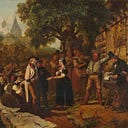Member-only story
ARTICLE REVIEW
On Disjuncture and Difference in the Global Culture Economy
A Review of Disjuncture and Difference in the Global Cultural Economy by Arjun Appadurai.

After reading this article about different aspects of global cultural flow, I went and checked the article’s date: It was published in 1990. The timing coincides with the end of the Cold War, an epochal event that prematurely led to Western liberal triumphalism and the accelerating pace of globalization. The new wave of a globalized economy, many thought, would bring the end of the nation-state. Appadurai wrote this piece well before Facebook, Twitter, YouTube, and other global vehicles of transnational information flow. He also wrote it before the global pandemic.
Unsatisfied with the social and cultural theories of postmodernism at the time, Appadurai offers his theoretical formulation to understand how the global cultural economy works out. Without wading into details, I’ll just briefly sketch out the basic contours of it. The global interactions of the 1990s were driven by the “tension between cultural homogenization and cultural heterogenization.” Appadurai paints five dimensions of global cultural flow: ethnoscapes, mediascapes, technoscapes, finanscapes, and ideoscapes. These terms, according to him, would explain…
